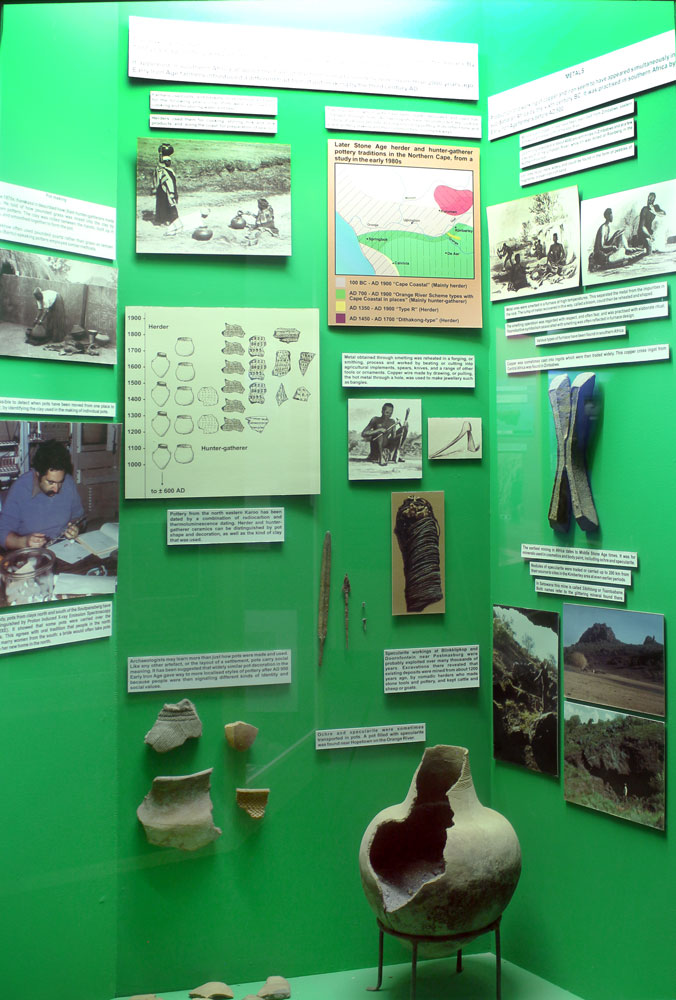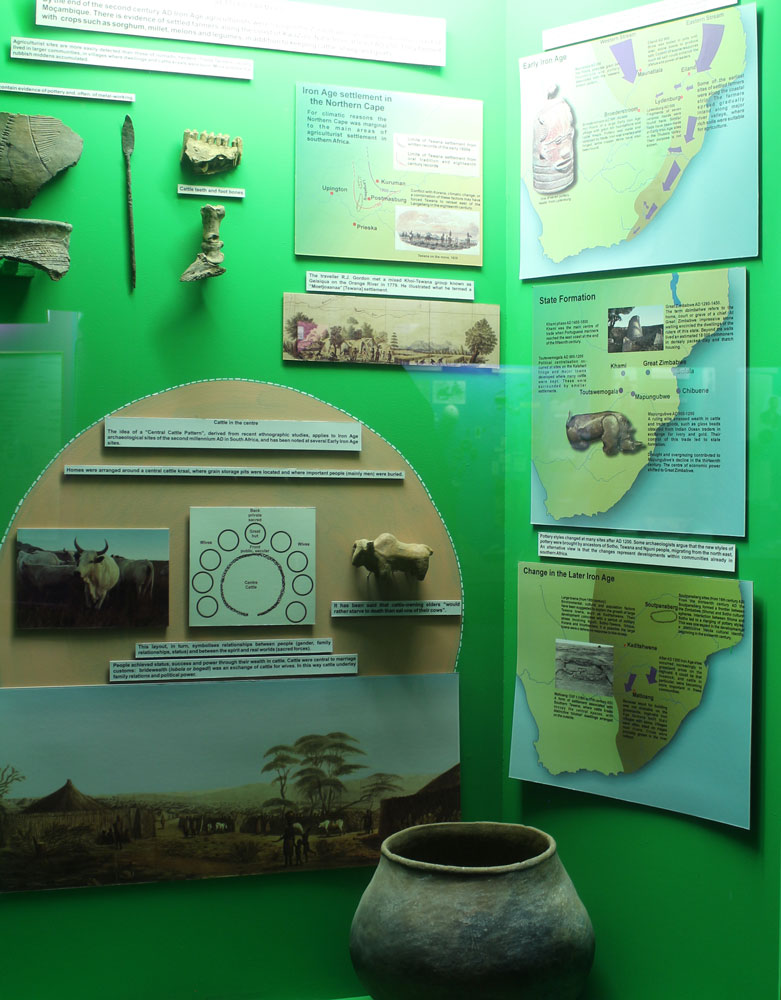Settled farmers
- Settled farmers
- https://museumsnc.co.za/new_site/wp-content/uploads/2021/04/settled-farmers-thumb.jpg
- ALL CATEGORIES
- https://museumsnc.co.za/new_site/wp-content/uploads/2021/04/Settled-Farmers-Voiceover.mp3

There is evidence of settled farmers along the coast of KwaZulu Nat al from at least AD 250. They farmed with crops such as sorghum, millet, melons and legumes, in addition to keeping cattle, sheep and goats. Early Iron Age sites were along the coastal strip, with farmers spreading gradually inland along major river valleys, where rich soils were suitable for agriculture.
Around AD 900 to 1200, political centralisation occurred at sites on the eastern Kalahari fringe, and major towns developed where many cattle were kept. These were surrounded by smaller settlements. A ruling elite at Mapungubwe at the same period amassed wealth in cattle and trade goods, such as glass beads obtained from Indian Ocean traders in exchange for ivory and gold. Their control of this trade led to state formation. Drought and overgrazing contributed to Mapugubwe’s decline in the thirteenth century. The centre of economic power shifted to Great Zimbabwe (AD 1290-1450).
Pottery styles changed at many sites after AD1200. Some archaeologists argue that the new styles of pottery were brought by ancestors of Sotho, Tswana and Nguni people, migrating from the north east. An alternative view is that the changes represent developments within communities already in southern Africa. After AD 1200, Iron Age sites occurred increasingly in grassland areas on the highveld. It could be that livestock, and cattle in particular, were becoming more important in these communities. Because wood for building was not available on the grasslands, highveld Iron Age farmers built their villages with stone. Villages were often situated on ridges near rivers. Crops were probably grown in the river valleys. Distinctive ‘bilobial’ dwellings, arranged around central cattle kraals, typify Tswana settlements from the seventeenth century onwards. From the eighteenth century these settlements became much larger. Environmental, cultural and population factors could have contributed to this; but their development also coincides with a period of military stress involving Nguni, Sotho-Tswana, Griqua, Korana and Voortrekkers. It is possible the large towns were a defensive response to this stress.
For climatic reasons the Northern Cape was marginal to the main areas of agriculturist settlement in southern Africa, and Tswana settlement appears to have been largely limited to the north eastern part of the province. Oral evidence recorded in the early nineteenth century indicates a more extensive westerly distribution in the late eighteenth century. The traveller R.J. Gordon met a mixed Khoi-Tswana group known as Geisiqua, on the Orange River, near modern Upington, in 1779. He illustrated what he termed a “Moetjoeanaa” – i.e. Tswana settlement.
The idea of a “Central Cattle Pattern”, derived from recent ethnographic studies, applies to archaeological sites dating back as far as Earlier Iron Age times in South Africa. Homes were arranged around a central cattle kraal, where grain storage pits were located and where important people (mainly men) were buried. This layout, in turn, symbolizes relationships between people (including gender, family relationships, and status), as well as between the spirit and real worlds – the sacred forces. People achieved status, success and power through their wealth in cattle. Cattle were central to marriage customs: bridewealth was an exchange of cattle for wives. In this way cattle underlay family relations and political power. It has been said that cattle-owning elders “would rather starve to death than eat one of their cows”.
Petrus Borcherds, at Dithakong (near Kuruman) in 1801 recorded that: “The herding of cattle, the milking of cows and everything thereto related are also important activities. With the arrival of the oxen from the fields, one may spy an orator mounting a high place or rock, and, with his hands on his hips, he addresses his favourite cow or ox with much praise.”
Farmers used pots (and baskets) to store food, and seed for the following year’s crop. Pots were also used for cooking and for storing water and beer. Ochre and specularite were sometimes transported in pots. At some Iron Age sites skeletons and burials of infants have been found inside pots. The manner in which pots have been made, decorated and used has changed through time. Archaeologists have reconstructed the cultural history of various periods and regions using pottery. Pots reflect time and place, and the pottery makers and their communities, in complex ways.
Iron hoes for agricultural work were of particular importance to early farmers. Iron was also used to make weapons. Metal items were exchanged in trade with groups who had no access to metal ore, or who did not practise metal-working.
Production and working of copper and iron was practised in southern Africa by Early Iron Age farmers before AD 500. Metal ores were smelted in a furnace at high temperatures. The smelting operation was regarded with respect, and often fear, and was practised with elaborate ritual. Reproductive symbolism associated with smelting was often reflected in furnace design.
Smelted metal was reheated in a forging, or smithing process, and worked by beating or cutting to make agricultural implements, spears, knives, and a range of other tools or ornaments. Copper wire made by drawing, or pulling the hot metal through a hole, was used to make jewellery such as bangles.
Mining in Africa predates the Iron Age however, as the earliest mining was for minerals used in cosmetics and body paint, including ochre and specularite. Specularite workings at Blinkklipkop and Doornfontain near Postmasburg in the Northern Cape were probably exploited over many thousands of years. Excavations there revealed that existing deposits were mined from about 1200 years ago, by nomadic herders who made stone tools and pottery, and kept cattle and sheep or goats. In Setswana this mine is called Sibihlong or Tsantsabane. Both names refer to the glittering mineral found there.

